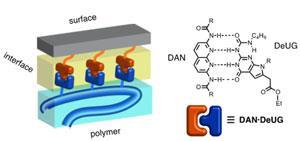
‘We wondered about the connection between nanoscale binding and macroscopic adhesion,’ says Steve Zimmerman, who led the research. ‘In particular, whether the binding energy of base pairs across an interface could lead to increased macroscopic adhesion.’
The researchers suspected that by adding DNA base pair analogues to surfaces they could create extremely strong, reversible linkages. Calculations suggested that if two surfaces were coated with complementary base pairs, and all the base pairs across the entire surface linked up, the resulting bond would be enormously strong. ‘In fact, the calculation suggested that if pulling the surfaces apart required rupturing all the base pairs at one time, the adhesive interaction would be a strong as steel!’ Zimmerman says. ‘That was an amazing idea.’
To test their theory they added one base pair to a glass surface and the complementary pair to a polymer film, using polystyrene as an adhesive. The results were encouraging, not only did the addition of base units improve the adhesive properties over the polystyrene alone, the adhesive could also be reset up to three times before the adhesion was reduced to the same level of stickiness as the unmodified polymer.
Jonathan Steed, a supramolecular chemist at Durham University, UK, is excited by the possibilities. ‘This type of system has huge potential to take advantage of the reversibility and versatility of non-covalent interactions, such as hydrogen bonding, to dial in exciting properties such as self-healing and specific surface recognition. It is quite remarkable how arrays of individually weak hydrogen bonding interactions, acting in concert, can add up to a very strongly bonded material.’
The Illinois team now plan to explore surface coatings that can enhance hydrogen bonding. They hope to produce an extremely strong adhesive that is completely reversible with the addition of a competing solvent that can ‘unstick’ the adhesive.
‘A polar solvent would break all the base pairing, so we envision an adhesive that is like steel – but add a drop of water or polar solvent and they come apart immediately,’ Zimmerman says. ‘A reversible glue that might be even better than Super Glue.’






No comments yet